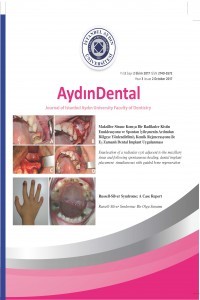EVALUATION OF ANTIBACTERIAL EFFECT OF TOOTHPASTES WITH DIFFERENT CONTENTS: AN IN VITRO STUDY
Antibacterial effect, fluoride, Streptococcus mutans, toothpaste, zone of inhibition
___
- [1] Saini S, Gupta N, Mahajan A, Arora DR, Aparna. Microbial flora in orodental infections. Indian J Med Microbiol. 2003;21(2):111-4.
- [2] Almas K, Mahmoud A, Dahlan A. A comparative study of propolis and saline application on human dentin. A SEM study. Indian J Dent Res. 2001;12(1):21-7.
- [3] Lee SS, Zhang W, Li Y. The antimicrobial potential of 14 natural herbal dentifrices: results of an in vitro diffusion method study. J Am Dent Assoc. 2004;135(8):1133-41.
- [4] O’Mullane DM, Baez RJ, Jones S, Lennon MA, Petersen PE, Rugg-Gunn AJ, et al. Fluoride and Oral Health. Community Dent Health. 2016;33(2):69-99.
- [5] Marsh PD. Dental plaque: biological significance of a biofilm and community lifestyle. J Clin Periodontol. 2005;32 Suppl 6:715.
- [6] N. B. Farklı Diş Macunlarının Antibakteriyel Etkilerinin İn vitro Olarak İncelenmesi. AÜ Diş Hek Fak Dergi 2014;41(2):77-84.
- [7] Frencken JE, Peters MC, Manton DJ, Leal SC, Gordan VV, Eden E. Minimal intervention dentistry for managing dental caries - a review: report of a FDI task group. Int Dent J. 2012;62(5):223-43.
- [8] De Rossi A, Ferreira DC, da Silva RA, de Queiroz AM, da Silva LA, NelsonFilho P. Antimicrobial activity of toothpastes containing natural extracts, chlorhexidine or triclosan. Braz Dent J. 2014;25(3):186-90.
- [9] Dulgergil CT AF, Bakir S. İçerikleri farklı dört diş macununun tükürük mutans streptokokları ve laktobasil düzeyine etkisi. Journal of Istanbul University Faculty of Dentistry. 1998;32(4):186-92.
- [10] Evans A, Leishman SJ, Walsh LJ, Seow WK. Inhibitory effects of children’s toothpastes on Streptococcus mutans, Streptococcus sanguinis and Lactobacillus acidophilus. Eur Arch Paediatr Dent. 2015;16(2):219-26.
- [11] Kalyoncu F, Oskay M, Sağlam H, Erdoğan TF, Tamer AU. Antimicrobial and antioxidant activities of mycelia of 10 wild mushroom species. J Med Food. 2010;13(2):415-9.
- [12 Roberts MC, Riedy CA, Coldwell SE, Nagahama S, Judge K, Lam M, et al. How xylitol-containing products affect cariogenic bacteria. J Am Dent Assoc. 2002;133(4):43541; quiz 92-3.
- [13] Trahan L, Néron S, Bareil M. Intracellular xylitol-phosphate hydrolysis and efflux of xylitol in Streptococcus sobrinus. Oral Microbiol Immunol. 1991;6(1):41-50.
- [14] Takarada K, Kimizuka R, Takahashi N, Honma K, Okuda K, Kato T. A comparison of the antibacterial efficacies of essential oils against oral pathogens. Oral Microbiol Immunol. 2004;19(1):61-4.
- [15] Carson CF, Hammer KA, Riley TV. Melaleuca alternifolia (Tea Tree) oil: a review of antimicrobial and other medicinal properties. Clin Microbiol Rev. 2006;19(1):50-62.
- [16] Amaechi BT, Porteous N, Ramalingam K, Mensinkai PK, Ccahuana Vasquez RA, Sadeghpour A, et al. Remineralization of artificial enamel lesions by theobromine. Caries Res. 2013;47(5):399-405.
- [17] Kargul B, Özcan M, Peker S, Nakamoto T, Simmons WB, Falster AU. Evaluation of human enamel surfaces treated with theobromine: a pilot study. Oral Health Prev Dent. 2012;10(3):275-82.
- [18] Domb WC. Ozone therapy in dentistry. A brief review for physicians. Interv Neuroradiol. 2014;20(5):632-6.
- [19] Polydorou O, Halili A, Wittmer A, Pelz K, Hahn P. The antibacterial effect of gas ozone after 2 months of in vitro evaluation. Clin Oral Investig. 2012;16(2):545-50.
- [20] T. P. Başlangıç Çürüklerinin Durdurulması ve Ozon ve Sealantların Kullanımı. Turkiye Klinikleri J Dental SciSpecial Topics. 2014;5(3):43-60.
- [21] Alpöz E, Çankaya H, Güneri P, Epstein JB, Boyacioglu H, Kabasakal Y, et al. Impact of Buccotherm® on xerostomia: a single blind study. Spec Care Dentist. 2015;35(1):1-7.
- [22] Yasar S.B AS, Kahraman L. Cinko Katkili Hidroksiapatitlerin Sentezi, Karakterizasyonu ve Antimikrobiyal Etkisi. 1 Cosmetic Congress; Antalya2011.
- [23] Moran J, Addy M, Corry D, Newcombe RG, Haywood J. A study to assess the plaque inhibitory action of a new zinc citrate toothpaste formulation. J Clin Periodontol. 2001
- ISSN: 2149-5572
- Yayın Aralığı: Yılda 3 Sayı
- Başlangıç: 2015
- Yayıncı: İstanbul Aydın Üniversitesi
RUSSELL-SILVER SYNDROME: A CASE REPORT
CONTROLLING CARIOUS LESIONS IN PRIMARY TEETH: A CHALLENGE
EVALUATION OF ANTIBACTERIAL EFFECT OF TOOTHPASTES WITH DIFFERENT CONTENTS: AN IN VITRO STUDY
ELEKTRONİK KÖK KANAL UZUNLUĞU ÖLÇÜM CİHAZLARI
ÇEKİMİ YAPILAN DAİMİ SANTRAL DİŞİN ORİJİNAL KRON İLE ESTETİK RESTORASYONU
